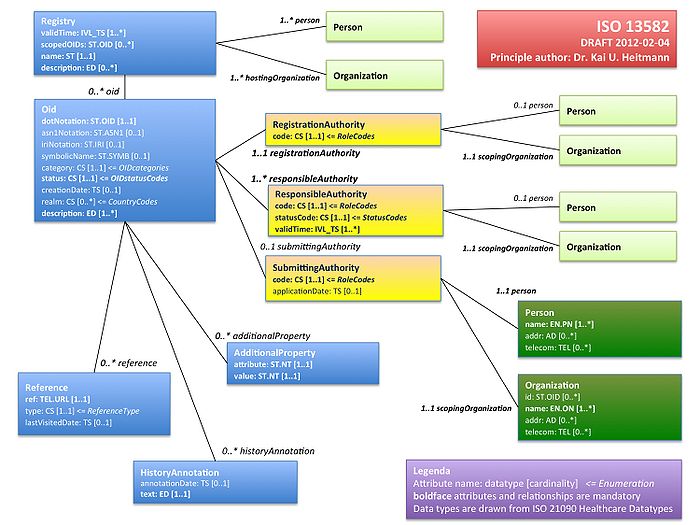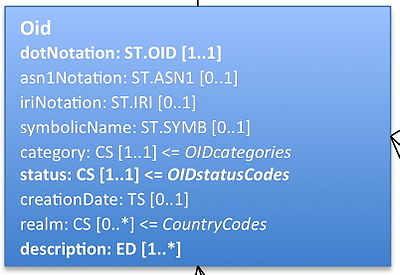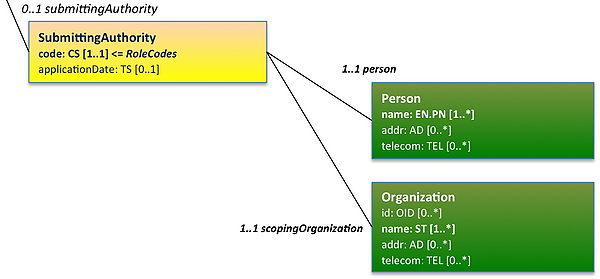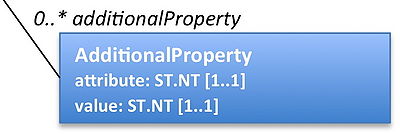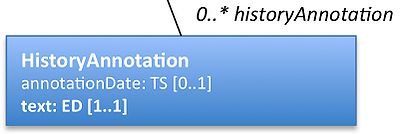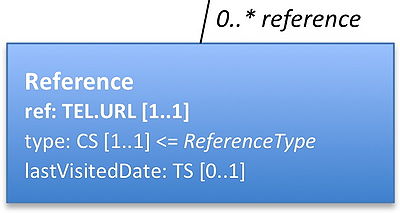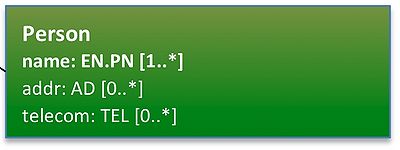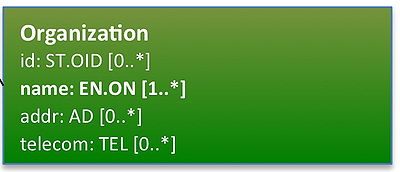ISO TC 215 - ISO TS 13582: Unterschied zwischen den Versionen
| Zeile 2: | Zeile 2: | ||
<div class="print-document-information"> | <div class="print-document-information"> | ||
| − | |||
{| border="0" cellpadding="15" class="print-document-logohead" | {| border="0" cellpadding="15" class="print-document-logohead" | ||
|- valign="top" | |- valign="top" | ||
| Zeile 8: | Zeile 7: | ||
International Organization for Standardization<br/>TC 215 Health Informatics | International Organization for Standardization<br/>TC 215 Health Informatics | ||
| − | |||
| Zeile 15: | Zeile 13: | ||
| − | |||
| − | |||
| − | |||
| − | |||
<div class="doc-title"> ISO 13582 - Health informatics<br/>Communication and metadata model and XML-interface specification for OID registries in healthcare </div> | <div class="doc-title"> ISO 13582 - Health informatics<br/>Communication and metadata model and XML-interface specification for OID registries in healthcare </div> | ||
Version vom 15. Mai 2011, 16:17 Uhr
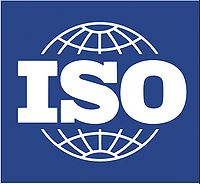
International Organization for Standardization
ISO 13582 - Health informatics
Communication and metadata model and XML-interface specification for OID registries in healthcare Technical Specification
Author: Dr. Kai U. Heitmann, Germany
Draft TS, not yet in ISO publication format
Inhaltsverzeichnis
History of Titles
ScopeThis International Standard specifies the mandatory and optional information to be recorded in any repository of OIDs, using an information model. It specifies what parts of that information shall be regarded as public, and what parts shall be subject to security and privacy requirements.
In detail, this International Standard:
IntroductionOID (Object Identifiers) are unique identifiers for any kind of objects. They are defined in Rec. ITU-T X.660 | ISO/IEC 9834-1[1]. This identification system for objects and concepts makes reliable electronic information exchange possible. Administration and Registration is regulated by a set of rules (see also ISO/NWIP/TR "Health Informatics – Guidance for maintenance of Object Identifiers OID"[2]). The precise designation of objects and concepts is a pre-requisite for the standardized exchange of information. A globally unique identifier for each of these concepts will help to ensure international exchangeability of objects within different applications (e.g. healthcare information systems). For example, OIDs are often used within HL7 messages and documents, and Rec. ITU-T X.509 certificates to provide this unique identification. In the exchange of healthcare information, especially between loosely coupled systems, additional information about the object being identified is generally very beneficial; this is information that is typically not contained in a transaction of data between systems but is reference information about the objects contained in the transaction. There is a minimal set of such information, such as Responsible Organizations, a human readable name, a description of the object, and other such information that is needed for any meaningful use of the objects identified. Since such information may not be locally available to a system examining the communicated objects, it makes sense to have such information available in a standardized form, and accessed by using the OID to identify this information. Such information, referred to as the OID metadata, is the bulk of the information housed in an OID Registry. Today, due to lack of standardization of the set of metadata (both content and structure), existing OID registries are not compatible. Contents, attributes and rules of the assignment of OIDs of existing registries are incompatible and often dissimilar. Many registries still distribute OIDs in a form only suitable for direct text processing (like spreadsheets) that is error prone and hard to automate. There is a need to store and transfer collections of OIDs and also to keep some registries completely in sync, maintaining the contents and the structure of metadata of each of the registered OIDs e.g. descriptions, comments, versions, links, relations, responsible organizations and persons, etc. Data exchange can be facilitated by a standardized representation of a required minimum set of metadata as an XML structure together with the associated checks of underlying constraints and business rules. This XML structure for importing and exporting OIDs amongst different registries should be achieved for supporting eHealth applications. In addition, the failure to have a standard for the operations needed to coordinated and synchronize the contents of disparate OID registries leads to confusion and ambiguity for the community that uses eHealth information containing references to objects identified by OIDs. There are currently at least hundreds of OID registries in active use throughout the world. These are sponsored and operated by disparate entities, ranging from national governments, to individual companies or standards organizations, to individuals in a specialized area or industry. In many cases, more than one of these registries address the same industry segment, and have overlapping content, i.e. specific OIDs exist in both, or worse, different OIDs identifying the same object exist in both. This distributed set of disparate registries servicing a particular industry (specifically Healthcare IT) has led to awkward and error prone searching processes. To get information about existing OIDs, a search within all existing registries is needed, for example to avoid duplicate assignment of multiple OIDs to one and the same concept. In order to standardize the activities to synchronise all existing OID registries and to ensure further interoperability it is essential to have a defined exchange format and business rules for maintenance of the OID registries that must cooperate in a particular industry. Some OID registries are operated by essentially volunteer organizations, such as Standards Bodies. The burden of administrative tasks is such that multiple individuals, often in different geographical locations, must participate to share the workload. Thus in addition to distributed Registry instances, administrative functions need to also be distributed, both on single and potentially across multiple Registries. There is a need for the standardization of a minimum set of administrative access and operational functions such that developers of Registries can deploy standard mechanisms to streamline and increase accuracy and productivity of these maintenance operations. This NWIP is a proposal for a new document and describes a generic exchange format that will cover the minimal set of metadata and associated rules for OIDs of existing registries. It specifies principles and processes that should be explored/implemented by developers and data administrators of OID registries and their applicant bodies. The primary target group for this document are those establishing OID Registries and those (industry, government bodies) using the services maintained by such organizations. Additional descriptionsA general description of the registration procedures for various parts of the object identifier tree, by reference to other specifications and links to other documents is given in ISO 13581 - Health informatics - Guidance for maintenance of object identifiers, OID - Technical Report. Annex A is a specific description for the registration procedures for e-health related OIDs, and includes a specification of those parts of the OID tree that are known to be used for national and for international e-health applications. Related workThis work is related to discussions about OID in the work programme of TC 215 WG3, HL7, ISO/IEC JTC 1/SC 6, ITU-T SG 17 and other organizations dealing with OIDs and OID registries. ApproachFollowing an extensive analysis of the currently available international OID register for health care systems, a basic data set and a corresponding XML representation as an exchange format need to be created for registering and exchanging OID-related data. To collect the very basic requirements to such a format an analysis of several registers (e.g. HL7 International[3] register and several European registers[4][5] was performed so far (see Table 1). The analysis included the contents, attributes and even the rules of the assignment of OID.
Only a few of the registers specified an (XML-) exchange format. Due to lack of a common understanding of OID registry requirements, data fields must be mapped (manually) when OID information needed to be exchanged. DefinitionsOID registry and OID repositoryAn OID registry maintains a list of OIDs. Typically additional information (metadata, such as responsible organizations, a human readable name, a description of the object, and other information that is needed for any meaningful use of the object identified) associated with the OID is stored also. With that, a registry is then a repository at the same time. Maintaining the list (and associated metadata) happens regardless whether it is an official register for allocations of new OIDs under a given OID arc, or just a copy of information from other registries. Official OID registries/repositories responsible for allocations of new OIDs under a given OID arc are Registration Authorities.
Registration Authority (RA)A Registration Authority (RA) is responsible for allocating child arcs to the OID that it manages (issuing authority). It ensures that an integer is used once among the subsequent arcs (child OIDs). As much as possible, it avoids the same identifier (beginning with a lowercase letter) being used for multiple sub-arcs. Such information is typically stored in the OID registry/repository but it is important to understand that an OID first need to be officially allocated by an RA before it can be described in an OID repository. For each child OID, the RA also keeps a record of additional information (like name of a contact person, postal address, telephone and fax numbers, email address, etc.) about the Responsible Authority for that child OID. A responsible authority for a child OID is formally becoming a RA for that child OID, as it may allocate sub arcs. Responsible Authority (MA)A Responsible (Managing) Authority (MA) is used to indicate the person (if known) and organization who is currently in charge of managing the OID. Once a responsible authority is allocating subarcs and registering information on these subarcs, it also becomes the Registration Authority for these subarcs. Submitting Authority (SA)This information is optional and reflects the person or organization that submitted the original OID allocation request. Relationship to definitions from other sourcesCurrent RegistrantIn some OID registries, Current Registrants are stored. The definitions from other sources say that the Current Registrant is used to indicate the person (if known) who is currently in charge of managing the OID, allocating subarcs and registering information on these subarcs.
First RegistrantIn some OID registries, First Registrants are stored. The definitions from other sources say that the First Registrant is used to indicate the very first person (if known) who was responsible to manage the OID and who created it in the first instance. Other sources: The first Registration Authority of an OID is the very first person or company to whom the OID was allocated by the RA of the superior OID. According to Rec. ITU-T X.660 | ISO/IEC 9834-1, the first RA can't be changed (if the responsibility is transferred to someone else, the information is recorded in the "Current Registration Authority" section, without changing the "First Registration Authority" section).
Rec. ITU-T X.660 | ISO/IEC 9834-1In ITU-T Recommendation X.660 the following defintions are given.
Abbreviations and acronymsTBD Use CasesA list of OID Registry Use Cases has been defined in order to drive metadata model requirements, and functional requirements for Registry interoperability. U1: OID Creation where the registry owner is the RACreation of a new OID in the standard ontological structureCreation of a new OID in a sub-structureU2: OID RegistrationRegistration where the registry owner created the OIDRegistration of an OID created elsewhereU3: OID Withdrawal/ReplacementWithdraw an OID created in error with no replacementWithdraw an OID created in error with specified replacementWithdraw an OID registered in error with no replacementWithdraw an OID registered in error with specified replacementWithdraw an OID that is found to be a duplicate, with original specifiedU4: OID Metadata Update/EditingPermissions modelDistributed effort modelProxies for EditorsU5: OID Information PublicationWeb presenceInternet-accessible API (Web service presence)Full registry output to machine-readable formFull registry output to human-readable formPartial registry output to machine-readable formPartial registry output to human-readable formU6: OID Information RequestSearch for the OID of an objectSearch for the object identified by an OIDSearch for a list of kinds of OIDsSearch for a list of OID based on various sub-criteria, with and without wildcards
Communication modelIn order to exchange OID and their metadata between different registers and applications the following additional data items beyond the OID itself need to be taken under consideration (see also [6] [7]):
A communication model with all classes, attributes and their properties aiming on a common understanding of the requirements of an OID registry has been created. XML exchange formatData exchange can be facilitated by a standardized representation of the complete set of information as XML structure together with the associated checks of underlying constraints and business rules. This XML structure for importing and exporting OID amongst different registries and other healthcare applications is aiming on the availability of reliable information about OIDs. The following sections summarise and explain classes and their attributes. ThisOIDregistryThis is the basic information about the OID-Registry hosting the OIDs. Attributes
validTimeThis is the validity time interval, i.e. the begin (and end) time when this registry is/was responsible for registering OIDs. This can be a list of intervals.
scopedOIDsList of scoped OIDs, i.e. the OIDs for which this OID-Registry is responsible for registration
nameOfficial name of the OID registry descA description of the OID registry Associations
Example<ThisOIDRegistry>
<validTime>
<low value="20100501"/>
</validTime>
<scopedOID value="1.2.3.4.5"/>
<name value="The best OID registry ever"/>
<desc value="This is a test OID registry, although the best"/>
<person> ... </person>
<organization> ... </organization>
<OID> ... </OID>
</ThisOIDRegistry>
OIDThis class contains the registered OID and the associated meta data. Attributes
dotNotationThe OID in dot notation of SNMP or ASN.1/XER. Example: 2.16.528 asn1NotationThe OID in ASN.1 notation with (optional) identifiers and numbers. Examples: {joint-iso-itu-t(2) country(16) nl(528)}
{itu-t(0) recommendation(0) a(1)}.
iriNotationThe OID in Internationalized Resource Identifier[8] (IRI) notation. Example: oid:/Country/528
symbolicName / Secondary Arc IdentifierA symbolic short name, unique among the siblings of the arc of the OID. The ISO rules on Secondary Arc Identifiers, as laid out in Rec. ITU-T | ISO/IEC 9834-1 Procedures for Registration Authorities, section 6.2.2, apply:
Example nl categoryType/category of OID, enumeration, values: OIDCategory There are actually two main types of OIDs: leafs (id of an object), and nodes representing an ontological branch. The types of node OID may be
The proposal for sub categories of leaf OIDs are
statusStatus of the OID. This is an enumeration, for values see: OIDstatus creationDateThe creationDate is used to describe when the OID was first registered. It is not the date when the OID description is submitted to the OID repository. The creationDate, once set, never changes. realmCode of country or "UV" for universal. This is an enumeration, for values see: CountryCodes. Associations
RegistrationAuthorityThis class represents the RegistrationAuthority (RA) Attributes
codeThe code holds information about the role type of the RA. Valid codes are listed in RoleCodes. Associations
ResponsibleAuthorityThis is a class representing the (managing) authority that is responsible for the object that is identified by the OID (not for the OID itself). Attributes
codeThe code holds information about the role type of the ResponsibleAuthority. Valid codes are listed in RoleCodes. statusCodeThe statusCode holds information about the status of the ResponsibleAuthority. Valid codes are listed in RoleStatus. validTimeThis is an interval of time, representing the period when the ResponsibleAuthority is/was responsible for the object that is identified by the OID. If the ResponsibleAuthority is still responsible, only the <low> element is populated. Associations
SubmittingAuthority(Please note: to avoid redundancy, the classes Organization and Peron are shown with attributes here, at all other places only a "shadow" class of these two classes is shown) Attributes
codeThe code holds information about the role type of the submitting authority. Valid codes are listed in RoleCodes. applicationDateDate of application (submission or certified submission) of the requested OID. Associations
DescriptionThis class contains a free text description of the OID ("what is the OID?"). The text typically contains an explaination but also can contain:
Attributes
AdditionalPropertyThis class reflects additional properties of an OID that might be used to fit business rules that cannot (or should not) be standardized. This includes:
It is made of an
HistoryAnnotationThis class reflects historical annotations of the OID and records the changes of any data over time. Attributes
ReferenceThis class provides a link to
The nature of the reference is coded in the type attribute, vocabulary is ReferenceType. Attributes
PersonAttributes
OrganizationAttributes
List of code systemsCountryCodesISO 3166-1 alpha two letter country codes are used[9][10]. This list states the country names as given in ISO 3166-1 and the corresponding ISO 3166-1-alpha-2 code elements. Example: NL LanguageCodesReflects the Human Language. Language is specified conformant to RFC 3066 (Tags for the Identification of Languages). The format is ss[-CC] where ss is the language code drawn from ISO-639-1[11], and CC is the country code, conformant to ISO-3166 alpha-2. Example: en-US OIDcategory
ObjectTypeType of object identified by the OID. In HL7 this is
OIDstatusThis code reflects the status of the OID. Valid values are:
ReferenceTypeThe type of reference covers the following values:
RoleCodesThis covers the kind of role:
RoleStatusThis covers the status of role:
Data typesISO data types[12] are used for the XML representation of data. In some cases additional flavors or constraints are defined. The following section gives examples and describes the restrictions / contraints on the generic specification. Address ADExample: <addr use="HP">
<part type="STR" value="Windsteiner Weg"/>
<part type="BNR" value="54a"/>
<part type="CNT" code="DEU" codeSystem=" 1.0.3166.1.2" value="D"/>
<part type="ZIP" value="14165"/>
<part type="CTY" value="Berlin"/>
</addr>
Coded Simple CSExample: <statusCode code="OBO"/>
Encapsulated Data ED(for mime: Text and HTML only (flavor id ED:TEXT, with language code) Example: <text value="this is plain text" language="en" mediaType="text/plain"/>
<text value="dieses ist normaler Text" language="de" mediaType="text/plain"/>
Entity Name for a person EN.PNExample: <name use="OR C">
<part type="GIV" value="Selby"/>
<part type="FAM" qualifier="SP" value="Butt"/>
<part type="FAM" value="Hadrian"/>
</name>
Interval of time stamp IVL_TSExample: <validTime>
<low value="20101201" />
<high value="20101224" />
</validTime>
String STA character string Example: <description value="I am a piece of text"/>
Object Identifier (dot notation) ST.OIDThis is actually a character string (ST) with a certain pattern. The pattern is: \{?\s*(0|[1-9][0-9]*)(\.(0|[1-9][0-9]*))*\s*\}?
Example: <oid value="1.2.3.4.5.0.6.7.8.9"/>
Object Identifier (asn1 notation) ST.ASN1This is actually a character string (ST) with a certain pattern. The pattern is: \{?\s*(([a-z][a-zA-Z0-9\-]*\s*((\s*(0|[1-9][0-9]*)\s*\))?|(0|[1-9][0-9]*))\s*){2,}\s*\}?
Object Identifier (iri notation) ST.IRIThis is actually a character string (ST) with a certain pattern. The pattern is: /^[a-z](?:[-a-z0-9\+\.])*:(?:\/\/(?:(?:%[0-9a-f][0-9a-f]|[-a-z0-9\._~\x{A0}-\x{D7FF}\x{F900}-\x{FDCF}\x{FDF0}-\x{FFEF}\x{10000}-\x{1FFFD}\x{20000}-\x{2FFFD}\x{30000}-\x{3FFFD}\x{40000}-\x{4FFFD}\x{50000}-\x{5FFFD}\x{60000}-\x{6FFFD}\x{70000}-\x{7FFFD}\x{80000}-\x{8FFFD}\x{90000}-\x{9FFFD}\x{A0000}-\x{AFFFD}\x{B0000}-\x{BFFFD}\x{C0000}-\x{CFFFD}\x{D0000}-\x{DFFFD}\x{E1000}-\x{EFFFD}!\$&'\(\)\*\+,;=:])*@)?(?:\[(?:(?:(?:[0-9a-f]{1,4}:){6}(?:[0-9a-f]{1,4}:[0-9a-f]{1,4}|(?:[0-9]|[1-9][0-9]|1[0-9][0-9]|2[0-4][0-9]|25[0-5])(?:\.(?:[0-9]|[1-9][0-9]|1[0-9][0-9]|2[0-4][0-9]|25[0-5])){3})|::(?:[0-9a-f]{1,4}:){5}(?:[0-9a-f]{1,4}:[0-9a-f]{1,4}|(?:[0-9]|[1-9][0-9]|1[0-9][0-9]|2[0-4][0-9]|25[0-5])(?:\.(?:[0-9]|[1-9][0-9]|1[0-9][0-9]|2[0-4][0-9]|25[0-5])){3})|(?:[0-9a-f]{1,4})?::(?:[0-9a-f]{1,4}:){4}(?:[0-9a-f]{1,4}:[0-9a-f]{1,4}|(?:[0-9]|[1-9][0-9]|1[0-9][0-9]|2[0-4][0-9]|25[0-5])(?:\.(?:[0-9]|[1-9][0-9]|1[0-9][0-9]|2[0-4][0-9]|25[0-5])){3})|(?:[0-9a-f]{1,4}:[0-9a-f]{1,4})?::(?:[0-9a-f]{1,4}:){3}(?:[0-9a-f]{1,4}:[0-9a-f]{1,4}|(?:[0-9]|[1-9][0-9]|1[0-9][0-9]|2[0-4][0-9]|25[0-5])(?:\.(?:[0-9]|[1-9][0-9]|1[0-9][0-9]|2[0-4][0-9]|25[0-5])){3})|(?:(?:[0-9a-f]{1,4}:){0,2}[0-9a-f]{1,4})?::(?:[0-9a-f]{1,4}:){2}(?:[0-9a-f]{1,4}:[0-9a-f]{1,4}|(?:[0-9]|[1-9][0-9]|1[0-9][0-9]|2[0-4][0-9]|25[0-5])(?:\.(?:[0-9]|[1-9][0-9]|1[0-9][0-9]|2[0-4][0-9]|25[0-5])){3})|(?:(?:[0-9a-f]{1,4}:){0,3}[0-9a-f]{1,4})?::[0-9a-f]{1,4}:(?:[0-9a-f]{1,4}:[0-9a-f]{1,4}|(?:[0-9]|[1-9][0-9]|1[0-9][0-9]|2[0-4][0-9]|25[0-5])(?:\.(?:[0-9]|[1-9][0-9]|1[0-9][0-9]|2[0-4][0-9]|25[0-5])){3})|(?:(?:[0-9a-f]{1,4}:){0,4}[0-9a-f]{1,4})?::(?:[0-9a-f]{1,4}:[0-9a-f]{1,4}|(?:[0-9]|[1-9][0-9]|1[0-9][0-9]|2[0-4][0-9]|25[0-5])(?:\.(?:[0-9]|[1-9][0-9]|1[0-9][0-9]|2[0-4][0-9]|25[0-5])){3})|(?:(?:[0-9a-f]{1,4}:){0,5}[0-9a-f]{1,4})?::[0-9a-f]{1,4}|(?:(?:[0-9a-f]{1,4}:){0,6}[0-9a-f]{1,4})?::)|v[0-9a-f]+[-a-z0-9\._~!\$&'\(\)\*\+,;=:]+)\]|(?:[0-9]|[1-9][0-9]|1[0-9][0-9]|2[0-4][0-9]|25[0-5])(?:\.(?:[0-9]|[1-9][0-9]|1[0-9][0-9]|2[0-4][0-9]|25[0-5])){3}|(?:%[0-9a-f][0-9a-f]|[-a-z0-9\._~\x{A0}-\x{D7FF}\x{F900}-\x{FDCF}\x{FDF0}-\x{FFEF}\x{10000}-\x{1FFFD}\x{20000}-\x{2FFFD}\x{30000}-\x{3FFFD}\x{40000}-\x{4FFFD}\x{50000}-\x{5FFFD}\x{60000}-\x{6FFFD}\x{70000}-\x{7FFFD}\x{80000}-\x{8FFFD}\x{90000}-\x{9FFFD}\x{A0000}-\x{AFFFD}\x{B0000}-\x{BFFFD}\x{C0000}-\x{CFFFD}\x{D0000}-\x{DFFFD}\x{E1000}-\x{EFFFD}!\$&'\(\)\*\+,;=@])*)(?::[0-9]*)?(?:\/(?:(?:%[0-9a-f][0-9a-f]|[-a-z0-9\._~\x{A0}-\x{D7FF}\x{F900}-\x{FDCF}\x{FDF0}-\x{FFEF}\x{10000}-\x{1FFFD}\x{20000}-\x{2FFFD}\x{30000}-\x{3FFFD}\x{40000}-\x{4FFFD}\x{50000}-\x{5FFFD}\x{60000}-\x{6FFFD}\x{70000}-\x{7FFFD}\x{80000}-\x{8FFFD}\x{90000}-\x{9FFFD}\x{A0000}-\x{AFFFD}\x{B0000}-\x{BFFFD}\x{C0000}-\x{CFFFD}\x{D0000}-\x{DFFFD}\x{E1000}-\x{EFFFD}!\$&'\(\)\*\+,;=:@]))*)*|\/(?:(?:(?:(?:%[0-9a-f][0-9a-f]|[-a-z0-9\._~\x{A0}-\x{D7FF}\x{F900}-\x{FDCF}\x{FDF0}-\x{FFEF}\x{10000}-\x{1FFFD}\x{20000}-\x{2FFFD}\x{30000}-\x{3FFFD}\x{40000}-\x{4FFFD}\x{50000}-\x{5FFFD}\x{60000}-\x{6FFFD}\x{70000}-\x{7FFFD}\x{80000}-\x{8FFFD}\x{90000}-\x{9FFFD}\x{A0000}-\x{AFFFD}\x{B0000}-\x{BFFFD}\x{C0000}-\x{CFFFD}\x{D0000}-\x{DFFFD}\x{E1000}-\x{EFFFD}!\$&'\(\)\*\+,;=:@]))+)(?:\/(?:(?:%[0-9a-f][0-9a-f]|[-a-z0-9\._~\x{A0}-\x{D7FF}\x{F900}-\x{FDCF}\x{FDF0}-\x{FFEF}\x{10000}-\x{1FFFD}\x{20000}-\x{2FFFD}\x{30000}-\x{3FFFD}\x{40000}-\x{4FFFD}\x{50000}-\x{5FFFD}\x{60000}-\x{6FFFD}\x{70000}-\x{7FFFD}\x{80000}-\x{8FFFD}\x{90000}-\x{9FFFD}\x{A0000}-\x{AFFFD}\x{B0000}-\x{BFFFD}\x{C0000}-\x{CFFFD}\x{D0000}-\x{DFFFD}\x{E1000}-\x{EFFFD}!\$&'\(\)\*\+,;=:@]))*)*)?|(?:(?:(?:%[0-9a-f][0-9a-f]|[-a-z0-9\._~\x{A0}-\x{D7FF}\x{F900}-\x{FDCF}\x{FDF0}-\x{FFEF}\x{10000}-\x{1FFFD}\x{20000}-\x{2FFFD}\x{30000}-\x{3FFFD}\x{40000}-\x{4FFFD}\x{50000}-\x{5FFFD}\x{60000}-\x{6FFFD}\x{70000}-\x{7FFFD}\x{80000}-\x{8FFFD}\x{90000}-\x{9FFFD}\x{A0000}-\x{AFFFD}\x{B0000}-\x{BFFFD}\x{C0000}-\x{CFFFD}\x{D0000}-\x{DFFFD}\x{E1000}-\x{EFFFD}!\$&'\(\)\*\+,;=:@]))+)(?:\/(?:(?:%[0-9a-f][0-9a-f]|[-a-z0-9\._~\x{A0}-\x{D7FF}\x{F900}-\x{FDCF}\x{FDF0}-\x{FFEF}\x{10000}-\x{1FFFD}\x{20000}-\x{2FFFD}\x{30000}-\x{3FFFD}\x{40000}-\x{4FFFD}\x{50000}-\x{5FFFD}\x{60000}-\x{6FFFD}\x{70000}-\x{7FFFD}\x{80000}-\x{8FFFD}\x{90000}-\x{9FFFD}\x{A0000}-\x{AFFFD}\x{B0000}-\x{BFFFD}\x{C0000}-\x{CFFFD}\x{D0000}-\x{DFFFD}\x{E1000}-\x{EFFFD}!\$&'\(\)\*\+,;=:@]))*)*|(?!(?:%[0-9a-f][0-9a-f]|[-a-z0-9\._~\x{A0}-\x{D7FF}\x{F900}-\x{FDCF}\x{FDF0}-\x{FFEF}\x{10000}-\x{1FFFD}\x{20000}-\x{2FFFD}\x{30000}-\x{3FFFD}\x{40000}-\x{4FFFD}\x{50000}-\x{5FFFD}\x{60000}-\x{6FFFD}\x{70000}-\x{7FFFD}\x{80000}-\x{8FFFD}\x{90000}-\x{9FFFD}\x{A0000}-\x{AFFFD}\x{B0000}-\x{BFFFD}\x{C0000}-\x{CFFFD}\x{D0000}-\x{DFFFD}\x{E1000}-\x{EFFFD}!\$&'\(\)\*\+,;=:@])))(?:\?(?:(?:%[0-9a-f][0-9a-f]|[-a-z0-9\._~\x{A0}-\x{D7FF}\x{F900}-\x{FDCF}\x{FDF0}-\x{FFEF}\x{10000}-\x{1FFFD}\x{20000}-\x{2FFFD}\x{30000}-\x{3FFFD}\x{40000}-\x{4FFFD}\x{50000}-\x{5FFFD}\x{60000}-\x{6FFFD}\x{70000}-\x{7FFFD}\x{80000}-\x{8FFFD}\x{90000}-\x{9FFFD}\x{A0000}-\x{AFFFD}\x{B0000}-\x{BFFFD}\x{C0000}-\x{CFFFD}\x{D0000}-\x{DFFFD}\x{E1000}-\x{EFFFD}!\$&'\(\)\*\+,;=:@])|[\x{E000}-\x{F8FF}\x{F0000}-\x{FFFFD}|\x{100000}-\x{10FFFD}\/\?])*)?(?:\#(?:(?:%[0-9a-f][0-9a-f]|[-a-z0-9\._~\x{A0}-\x{D7FF}\x{F900}-\x{FDCF}\x{FDF0}-\x{FFEF}\x{10000}-\x{1FFFD}\x{20000}-\x{2FFFD}\x{30000}-\x{3FFFD}\x{40000}-\x{4FFFD}\x{50000}-\x{5FFFD}\x{60000}-\x{6FFFD}\x{70000}-\x{7FFFD}\x{80000}-\x{8FFFD}\x{90000}-\x{9FFFD}\x{A0000}-\x{AFFFD}\x{B0000}-\x{BFFFD}\x{C0000}-\x{CFFFD}\x{D0000}-\x{DFFFD}\x{E1000}-\x{EFFFD}!\$&'\(\)\*\+,;=:@])|[\/\?])*)?$/i
Symbolic name ST.SYMBThis is actually a character string (ST) with a certain pattern. The pattern is: ^[a-z]([a-z]|[A-Z]|[0-9]|[\-][^-])*([^-])?$
Telecommunication TELExample: <telecom value="tel:+491234567890" use="H WP" capabilities="voice fax"/>
Time stamp TSExample: <applicationDate value="20101205"/>
Uniform Resource Identification URIThis is actually a character string with a certain pattern. Example: <uri value="http://x.y.org"/>
Basic interactions between OID registriesA set of basic interactions is developed and documented in order to facilitate the exchange of OID-related information between registries. This will include at least the following transactions:
Annex AAnnex A is a specific description for the registration procedures for e-health related OIDs, and includes a specification of those parts of the OID tree that are known to be used for national and for international e-health applications. References
|
